Conceptual Design of Public Charging Stations for Freight Road Transport
Abstract
:1. Introduction
2. Methods
2.1. Location of Charging Stations
2.1.1. Phase 1: Urban Nodes and Core TEN-T
2.1.2. Phase 2: Densification of the Core TEN-T Network and Basic Coverage of the Comprehensive TEN-T Network
2.1.3. Phase 3 (Figure 4): Densification of the Comprehensive TEN-T Network, Additional Coverage of the Czech Republic

2.2. Methodology of Choosing the Concept of Charging Stations for Road Freight Transport
2.2.1. Input Parameters
- Traffic intensity in the area on workdays [9],
- Data from Technical Conditions 189: daily, weekly, and yearly variations in traffic intensity [11],
- Data from Technical Conditions 171: dimensions of vehicles in each category [14],
- Data from ČSN 73 6056: minimum distances between vehicles in each category in perpendicular parking [15],
- Traffic output of main and other routes in the catchment area [10],
- Electricity consumption [12],
- The ratio of battery electric vehicles (BEV) and the ratio of public charging, in the form of scenarios (sets of parameters),
- Probability of overnight charging of BEV, if the vehicle arrives at night,
- BEV parameters: range, charging current of the traction battery in xC units, Current stated in units of a multiple of the battery capacity.
- Selected power of charging outlets (e.g., 43, 170, 350 kW),
- Free capacity of the nearest transformer station (MVA),
- Distance to high-voltage power lines,
- High-voltage level,
- Dimensions of the charging stand structure.
2.2.2. Calculation
2.2.3. Load Diagrams
2.2.4. Occupancy
2.2.5. Climatic Conditions
2.2.6. Estimation of Reserved Capacity
2.2.7. Station Battery
2.2.8. Space Requirements
3. Results
3.1. Results of Location of Charging Stations (Step 1)
3.1.1. Year 2025: Phase 1
3.1.2. Year 2030: Phase 2 (Figure 3)
3.1.3. Year 2035: Phase 3
3.1.4. Charging Stations Overview
3.2. Results of Power and Spatial Needs (Step 2)
3.2.1. Scenarios
- AFIR_EK: The scenario is determined by the requirements formulated in the original proposal of AFIR by the European Commission [7] for CHS in the years 2025, 2030, and 2035 (max charging power 350 kW).
- AFIR_EP: The scenario is determined by the requirements of AFIR broadened by a proposal of the European Parliament for CHS in the years 2025, 2027, 2030, and 2032 (max charging power 700 kW; see report to [8] from February 2022).
3.2.2. Parameters for Charging Stations
- CHS Cap: Maximum monthly reserved capacity of the lines (MVA),
- Energy: Annual energy consumption (GWh),
- Techl./Park. Area: Required area of the charging technology and parking (m2),
- MissPark: Total missing parking area for all charging stations (m2),
- MissDistr: Power deficiency of the distribution network (MVA),
- Stat. Batt: Nominal energy of the station batteries of all charging stations (MWh),
- ChPts: Number of charging points for individual power levels.
- AFIR_EK for power levels of charging stations at 170 and 350 kW,
- AFIR_EP for power levels of charging stations at 170 and 700 kW,
- Phase 1, according to the methodology for power levels of charging stations at 170 and 350 kW,
- Phase 2, according to the methodology for power levels of charging stations at 170 and 350 kW,
- Phase 3, according to the methodology for power levels of charging stations at 170 and 350 kW,
- Phase 3, according to the methodology for power levels of charging stations at 170, 350, and 700 kW,
- Verification calculation with 100% share of BEVs and 100% share of public charging for power levels from the set {170, 350} or {170, 350, 700} kW.
3.3. Graphical Results
3.3.1. Power Distribution Demands
3.3.2. Spatial Demands for Parking
3.4. Comment on Numerical Results
3.4.1. Scenario AFIR_EK
3.4.2. Scenario AFIR_EP
3.4.3. Scenario INDUSTRY BASELINE According to the Methodology
3.4.4. Scenario EV-Leaders According to the Methodology
3.4.5. Scenario Road-2-Zero According to the Methodology
4. Conclusions
Author Contributions
Funding
Data Availability Statement
Acknowledgments
Conflicts of Interest
References
- Mortimer, B.J.; Hecht, C.; Goldbeck, R.; Sauer, D.U.; De Doncker, R.W. Electric Vehicle Public Charging Infrastructure Planning Using Real-World Charging Data. World Electr. Veh. J. 2022, 13, 94. [Google Scholar] [CrossRef]
- Unterluggauer, T.; Rich, J.; Andersen, P.B.; Hashemi, S. Electric vehicle charging infrastructure planning for integrated transportation and power distribution networks: A review. ETransportation 2022, 12, 100163. [Google Scholar] [CrossRef]
- Balcioglu, G. (Ed.) Charging Infrastructure Electromobility. DKE–German Commission for Electrical, Electronic & Information Technologies in DIN and VDE; DKE–VDE Association for Electrical, Electronic & Information Technologies: Offenbach am Main, Germany, 2022. [Google Scholar]
- Speth, D.; Plötz, P.; Funke, S.; Vallarella, E. Public fast charging infrastructure for battery electric trucks–a model-based network for Germany. Environ. Res. Infrastruct. Sustain. 2022, 2, 025004. [Google Scholar] [CrossRef]
- Speth, D.; Sauter, V.; Plötz, P. Where to Charge Electric Trucks in Europe–Modelling a Charging Infrastructure Network. In Proceedings of the 35th International Electric Vehicle Symposium and Exhibition (EVS35), Oslo, Norway, 11–15 June 2022; Available online: https://publica-rest.fraunhofer.de/server/api/core/bitstreams/4940547d-9398-40ae-90a3-a2d35201b895/content (accessed on 10 July 2023).
- Regulation of the European Parliament and of the Council on the Deployment of Alternative Fuels Infrastructure, and Repealing Directive 2014/94/EU of the European Parliament and of the Council, Brussels, 13.7.2023, 2021/0223(COD) (AFIR). Available online: https://eur-lex.europa.eu/legal-content/en/TXT/?uri=CELEX%3A52021PC0559 (accessed on 15 October 2023).
- Proposal for a Regulation of the European Parliament and of the Council on the Deployment of Alternative Fuels Infrastructure, and Repealing Directive 2014/94/EU of the European Parliament and of the Council, Brussels, 14.7.2021, COM(2021) 0559 Final, European Commission (AFIR–Proposal of EC). Available online: https://eur-lex.europa.eu/legal-content/EN/TXT/PDF/?uri=CELEX:52021DC0550&from=EN (accessed on 23 December 2023).
- Draft European Parliament Legislative Resolution on the proposal for a Regulation of the European Parliament and of the Council on the Deployment of Alternative Fuels Infrastructure, and Repealing Directive 2014/94/EU of the European Parliament and of the Council, Brussels, 19.10.2022, COM(2021) 0559–C9-0331/2021–2021/2023(COD), European Parliament (AFIR–Proposal of EP for Trilogue Negotations). Available online: https://eur-lex.europa.eu/legal-content/EN/TXT/HTML/?uri=OJ:C:2022:209:FULL&from=EN (accessed on 23 December 2023).
- Ministry of Transport ČR. National Traffic Census-Celostátní Sčítání Dopravy 2016, ŘSD. Available online: http://scitani2016.rsd.cz/ (accessed on 10 July 2023).
- Hykš, O. Tabulky dopravních výkonů v atrakčních obvodech jednotlivých nabíjecích stanic, Output of the project grant TAČR Théta 2 TK02010106 Čistá mobilita a její perspektiva.
- Ministry of Transport ČR, Document TP 189, Stanovení Intenzit Dopravy na Pozemních Komunikacích, Technické Podmínky. 2018. Available online: https://pjpk.rsd.cz/data/USR_001_2_8_TP/TP_189_2018_final.pdf (accessed on 6 October 2023).
- Hykš, O. Měrná spotřeba pro jednotlivé kategorie vozidel, model SUMO, Mgr. Oldřich Hykš, Output of the project grant TAČR Théta 2 TK02010106 Čistá mobilita a její perspektiva.
- Croce, A.I.; Musolino, G.; Rindone, C.; Vitetta, A. Traffic and Energy Consumption Modelling of Electric Vehicles: Parameter Updating from Floating and Probe Vehicle Data. Energies 2022, 15, 82. [Google Scholar] [CrossRef]
- Ministry of Transport ČR. Document TP 171, Vlečné křivky pro ověřování průjezdnosti směrových prvků pozemních komunikací, Technické podmínky, 2005.
- ČSN 73 6056; Odstavné a Parkovací Plochy Silničních Vozidel. MDT: Praha, Czech Republic, 1987.
- Mathieu, L. Unlocking Electric Trucking in the EU: Recharging in Cities; Transport & Environment: Brussels, Belgium, 2020; Available online: https://www.smarttransport.org.uk/whitepapers/reports-1/unlocking-the-electric-trucking-in-the-eu-recharging-in-cities (accessed on 10 July 2023).
- Suzan, S.; Mathieu, L. Unlocking Electric Trucking in the EU: Recharging along Highways, Electrification of Long-Haul Trucks; Transport & Environment: Brussels, Belgium, 2021; Volume 2. [Google Scholar]
- ČHMÚ, Database of Emtorologicla Reports, Regular Meteorological Meassurements Praha. Available online: https://www.chmi.cz/historicka-data/pocasi/praha-klementinum# (accessed on 10 October 2023).
- Bínová, H.; Hykš, O.; Hospodka, J.; Kekula, F.; Neubergová, K.; Sadil, J. Document Metodika pro volbu koncepce nabíjecí stanice pro nákladní silniční dopravu, verze 4-0, 2022, Output of the project grant TAČR Théta 2 TK02010106 Čistá mobilita a její perspektiva.
- Ahmadian, A.; Mohammadi-ivatloo, B.; Elkamel, A. Electric Vehicles in Energy Systems: Modelling, Integration, Analysis, and Optimization; Springer Nature: Cham, Switzerland, 2020; ISBN 978-3-030-34448-1. [Google Scholar]
- Mathieu, L. Recharge EU Trucks: Time to Act! Transport & Environment: Brussels, Belgium, 2020; Available online: https://evmarketsreports.com/recharge-eu-trucks-time-to-act/ (accessed on 10 July 2023).
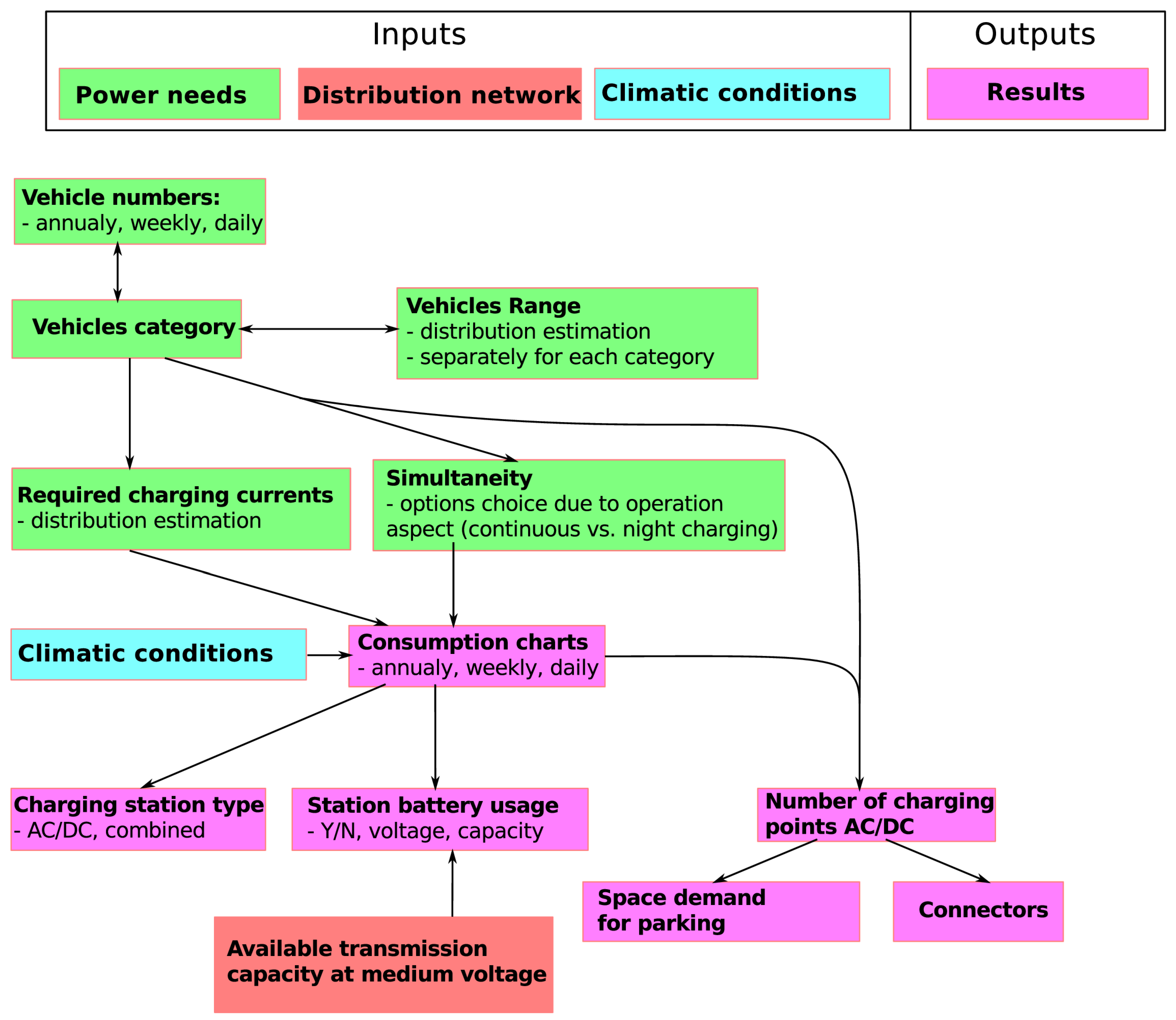

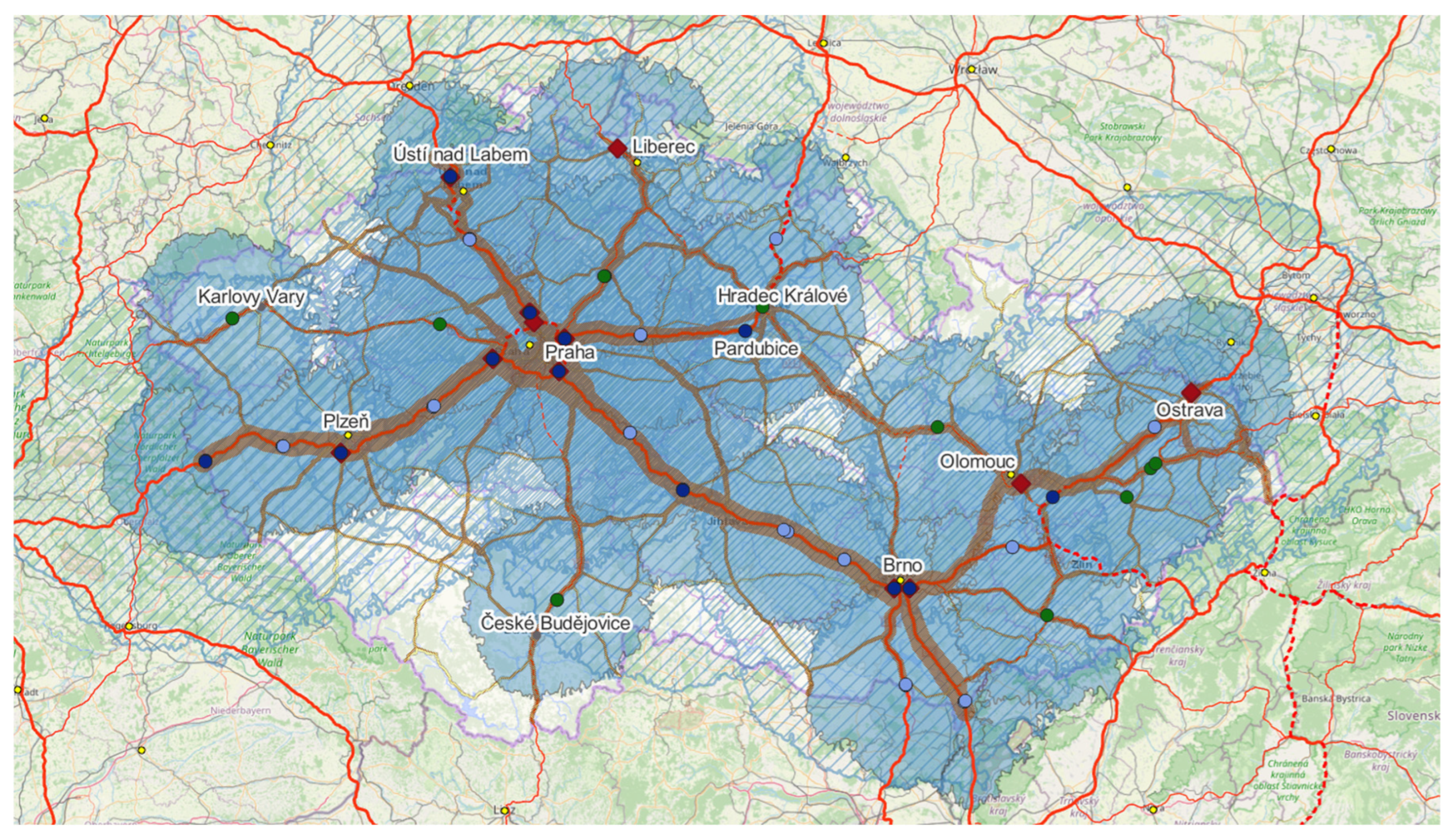
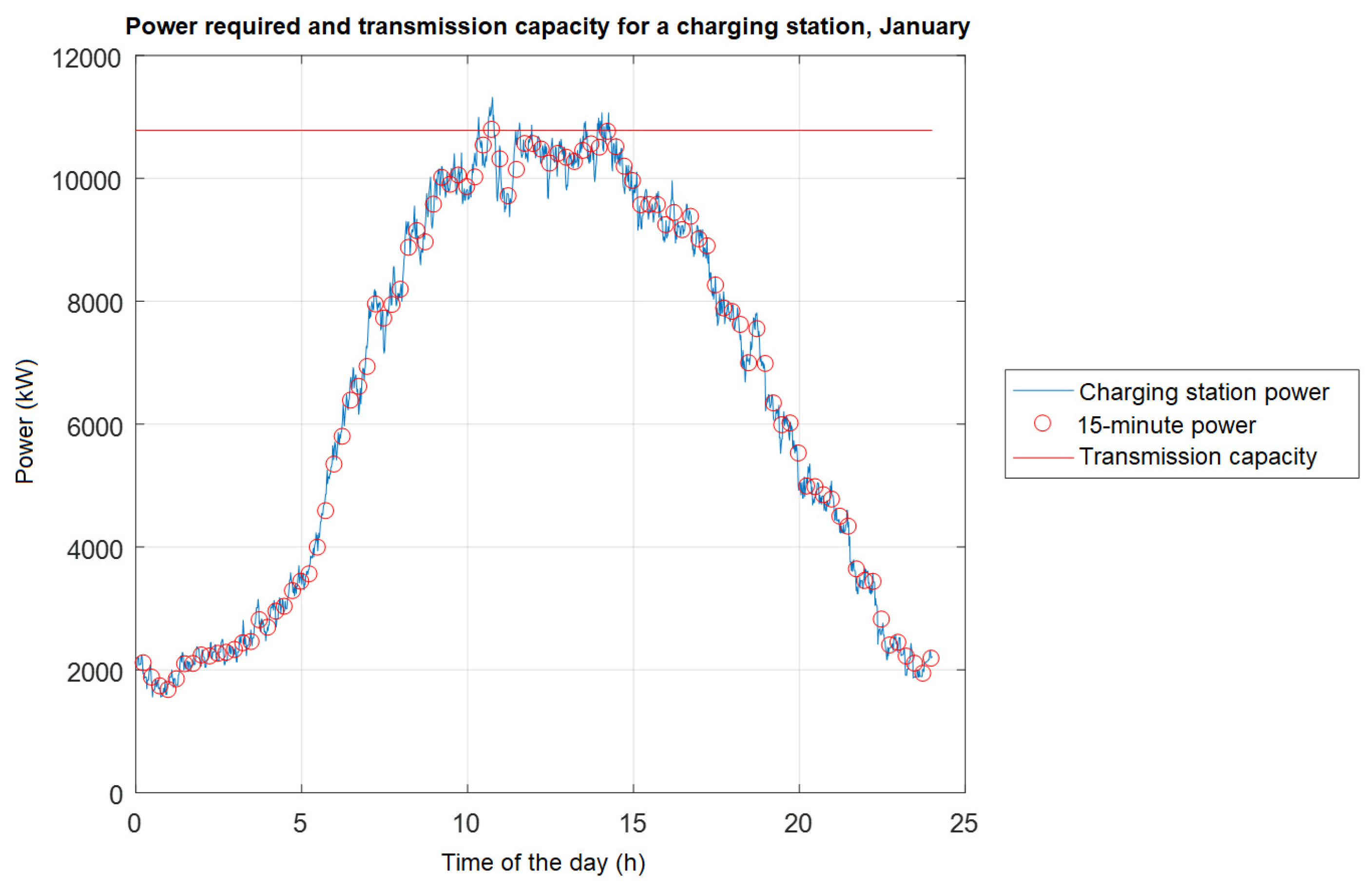
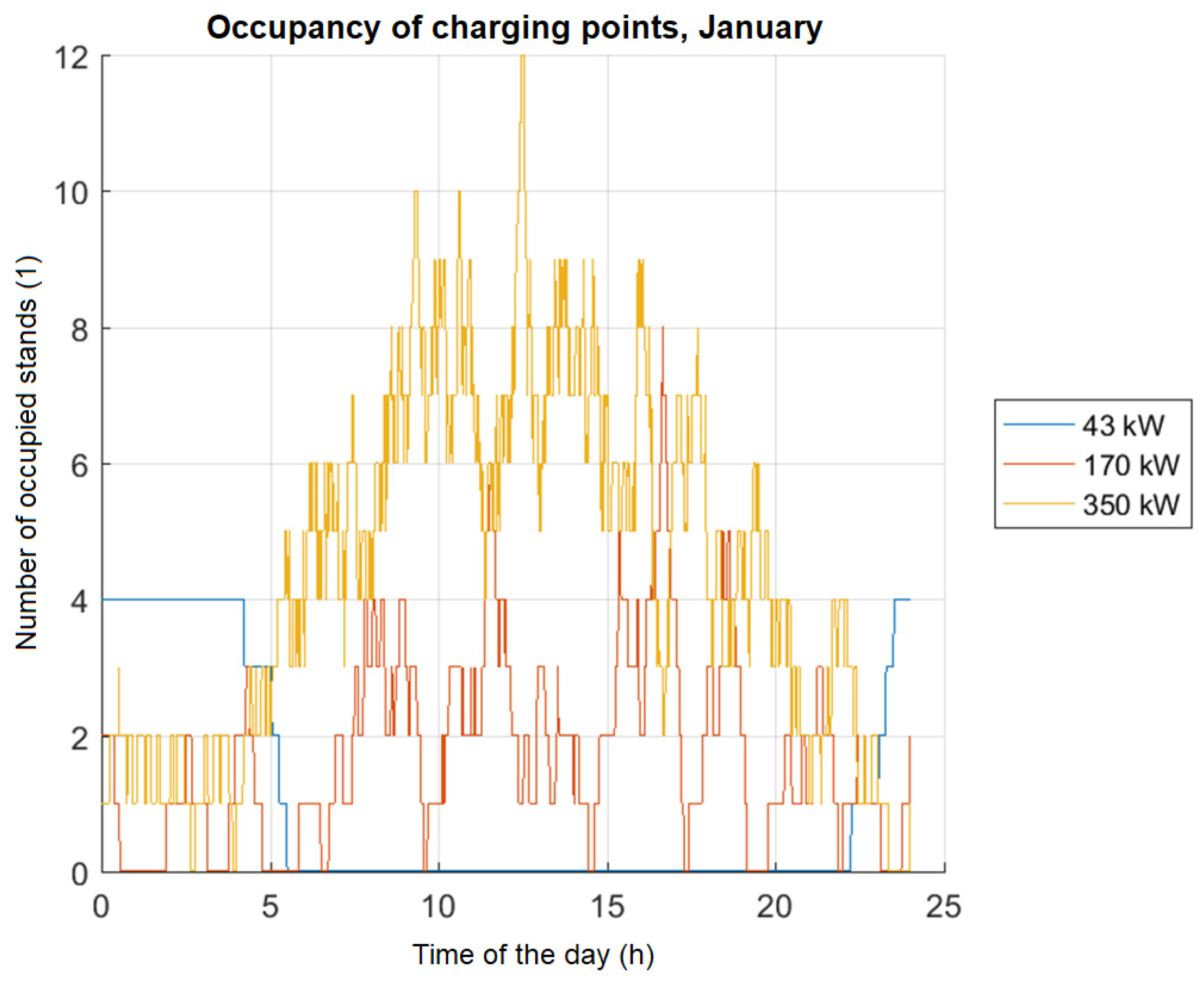

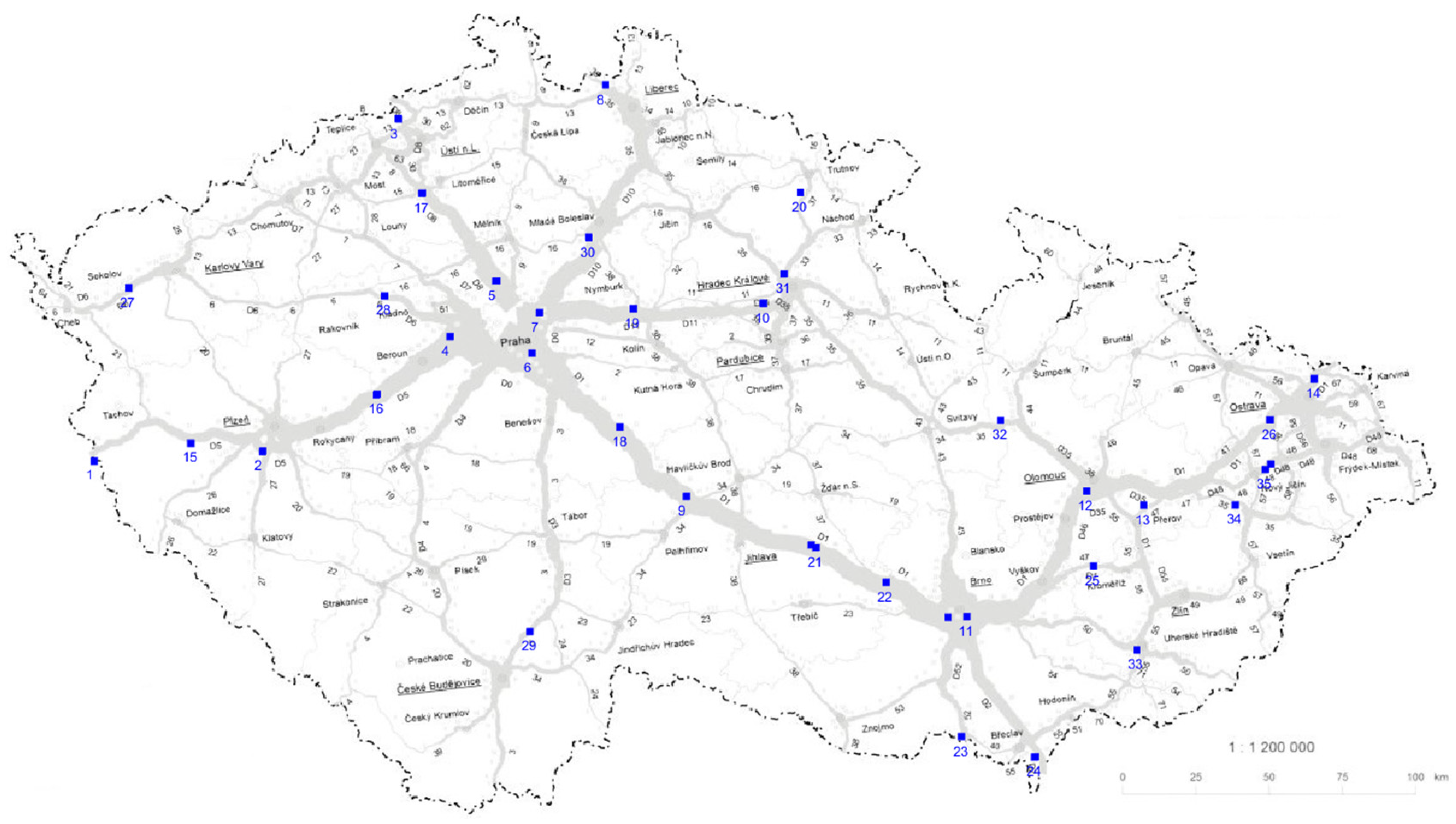
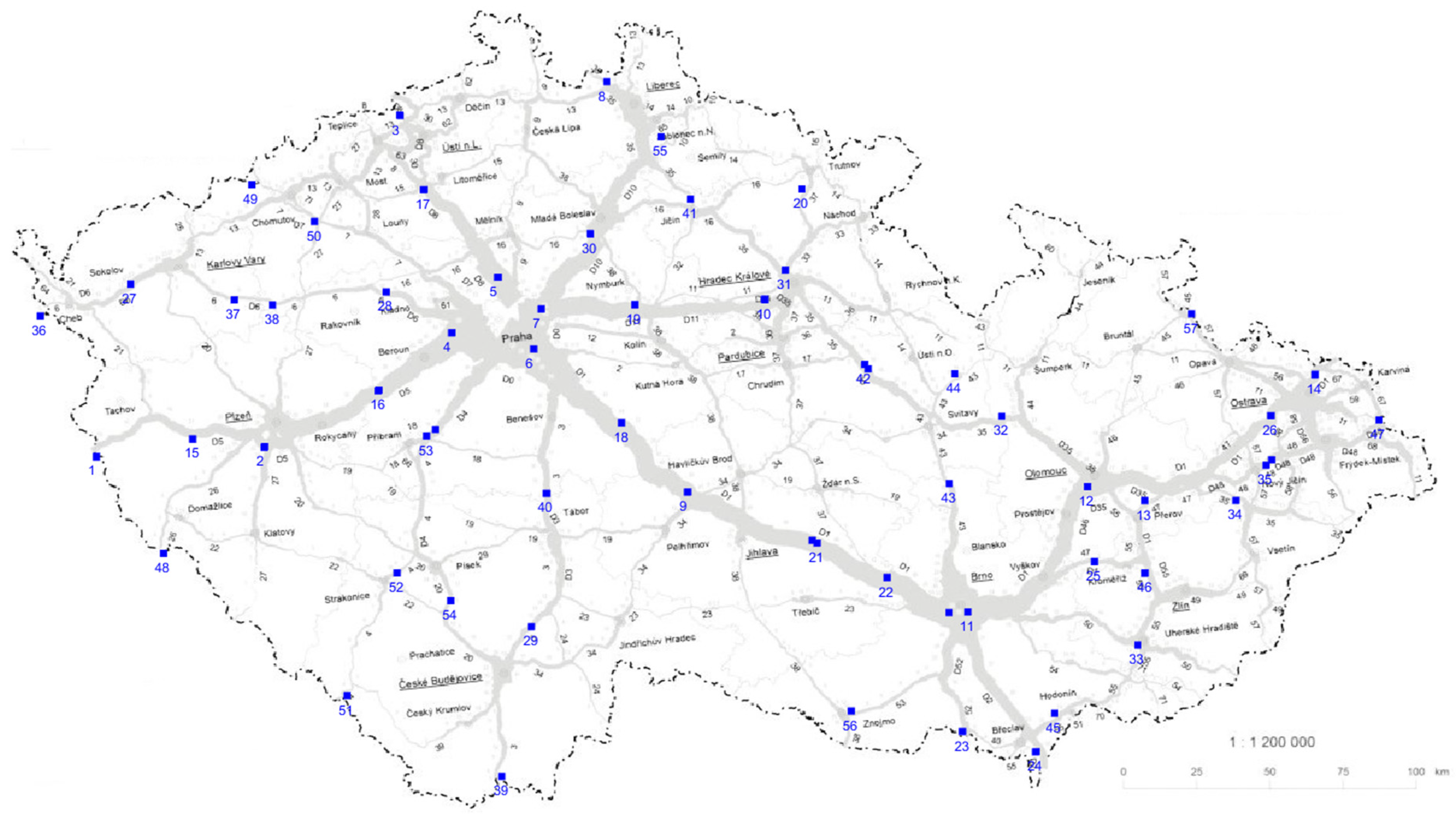
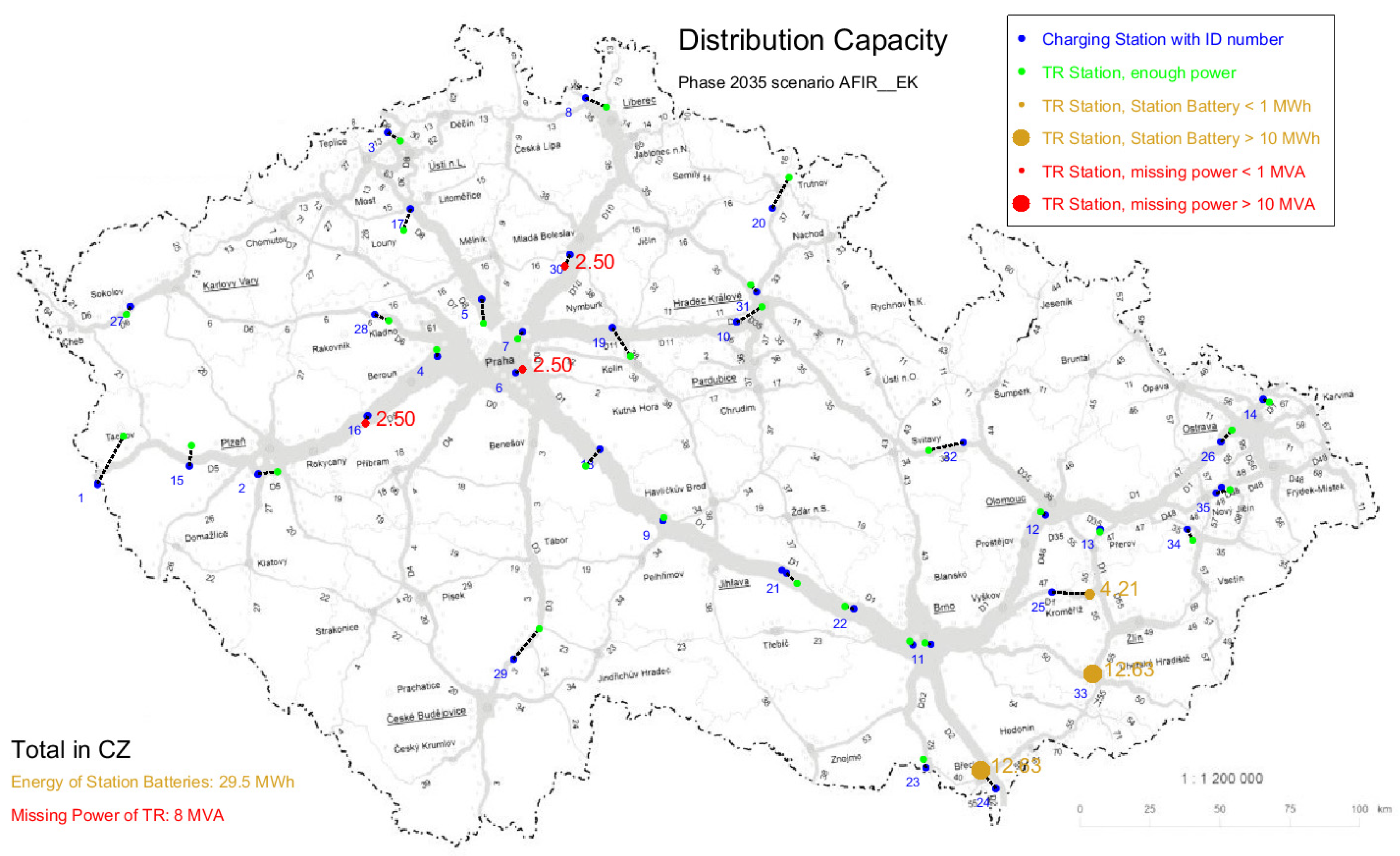
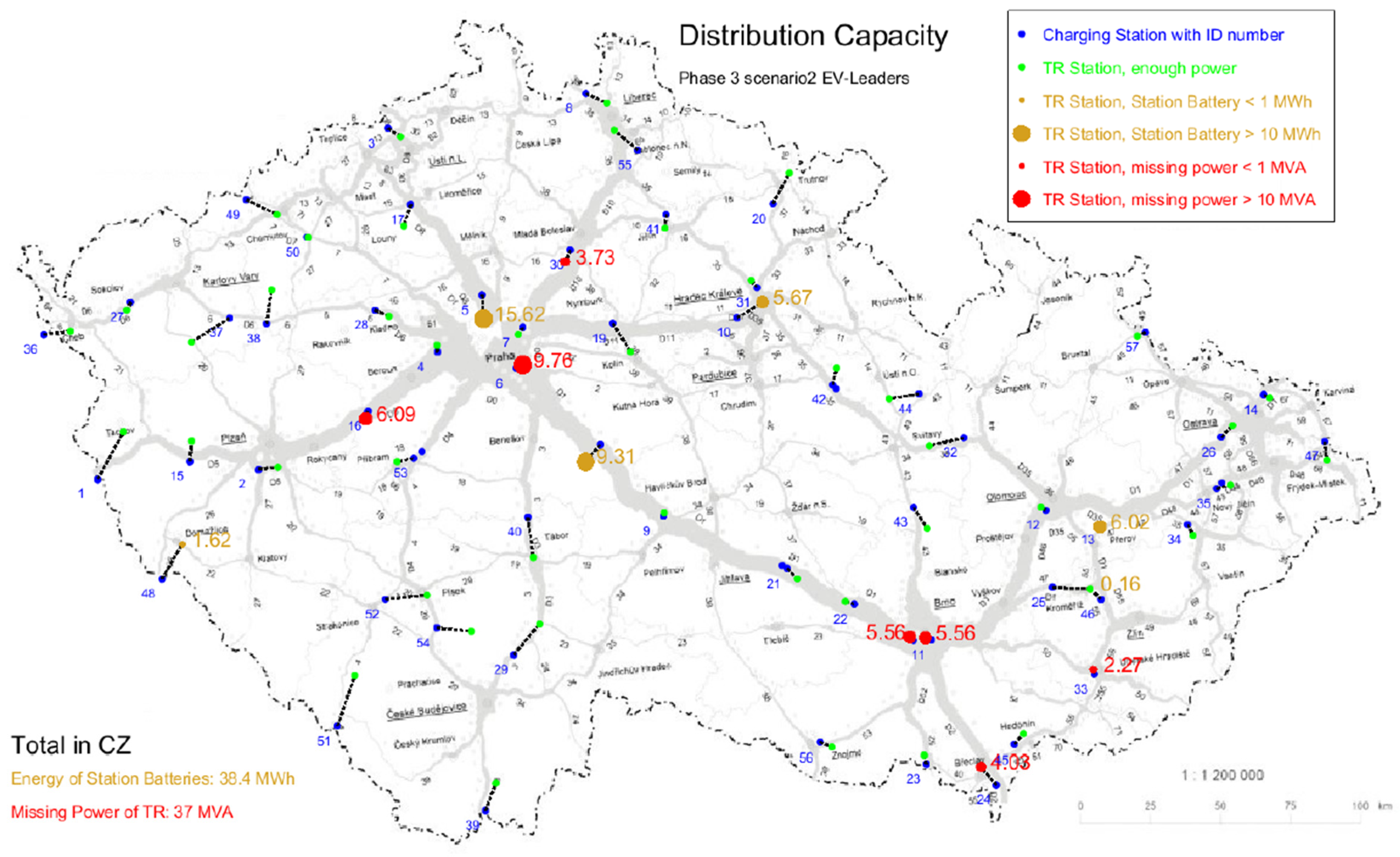
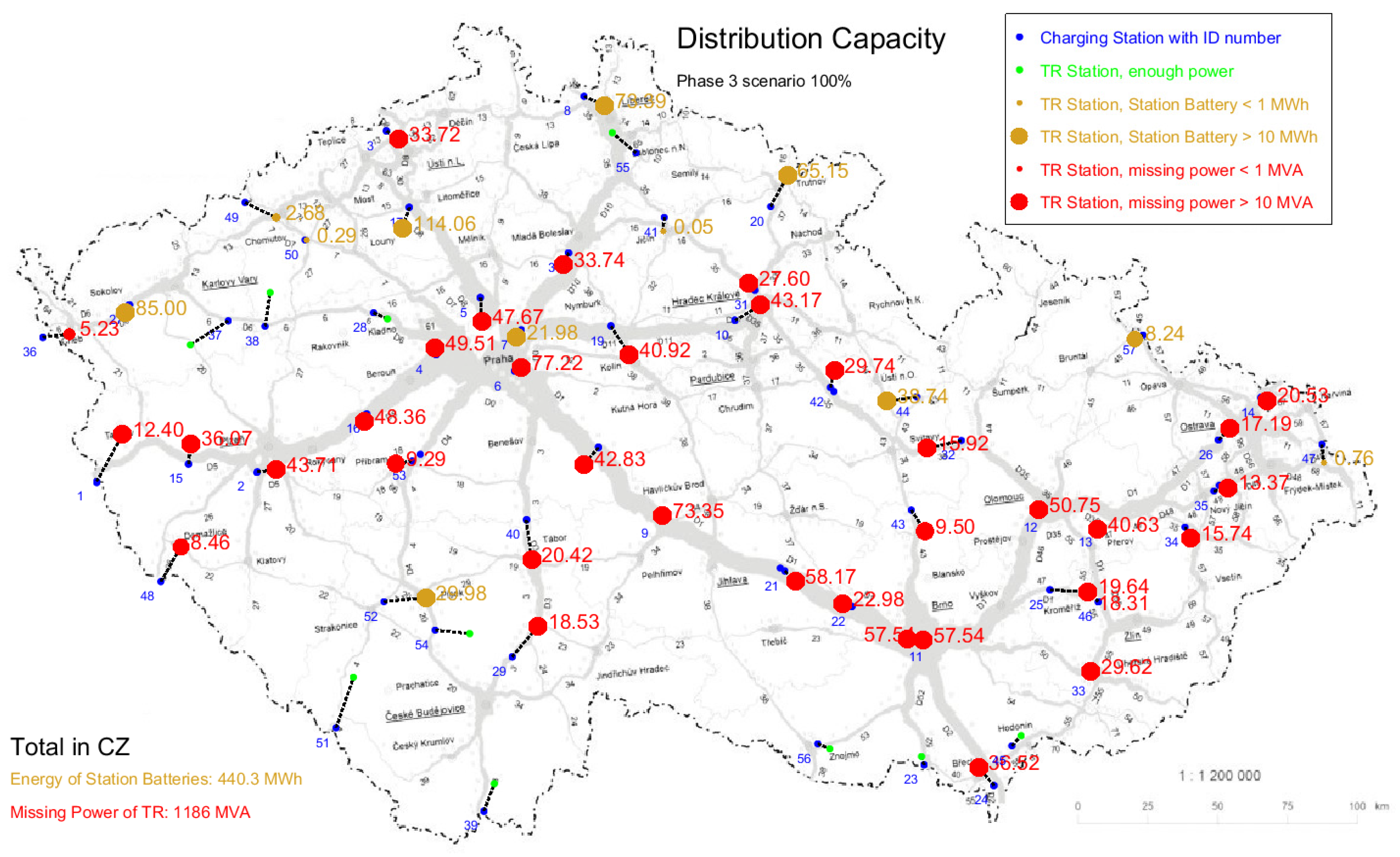

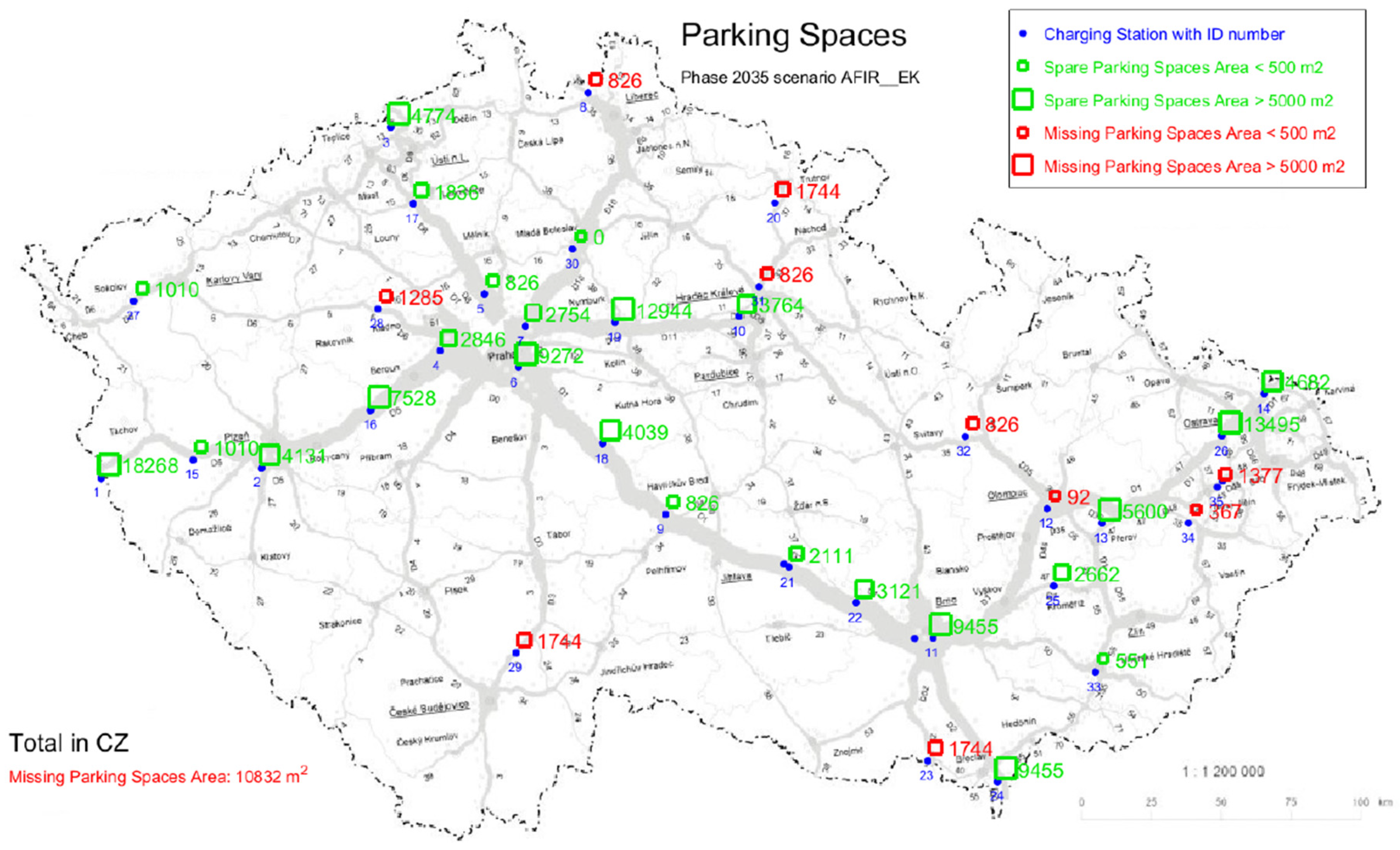

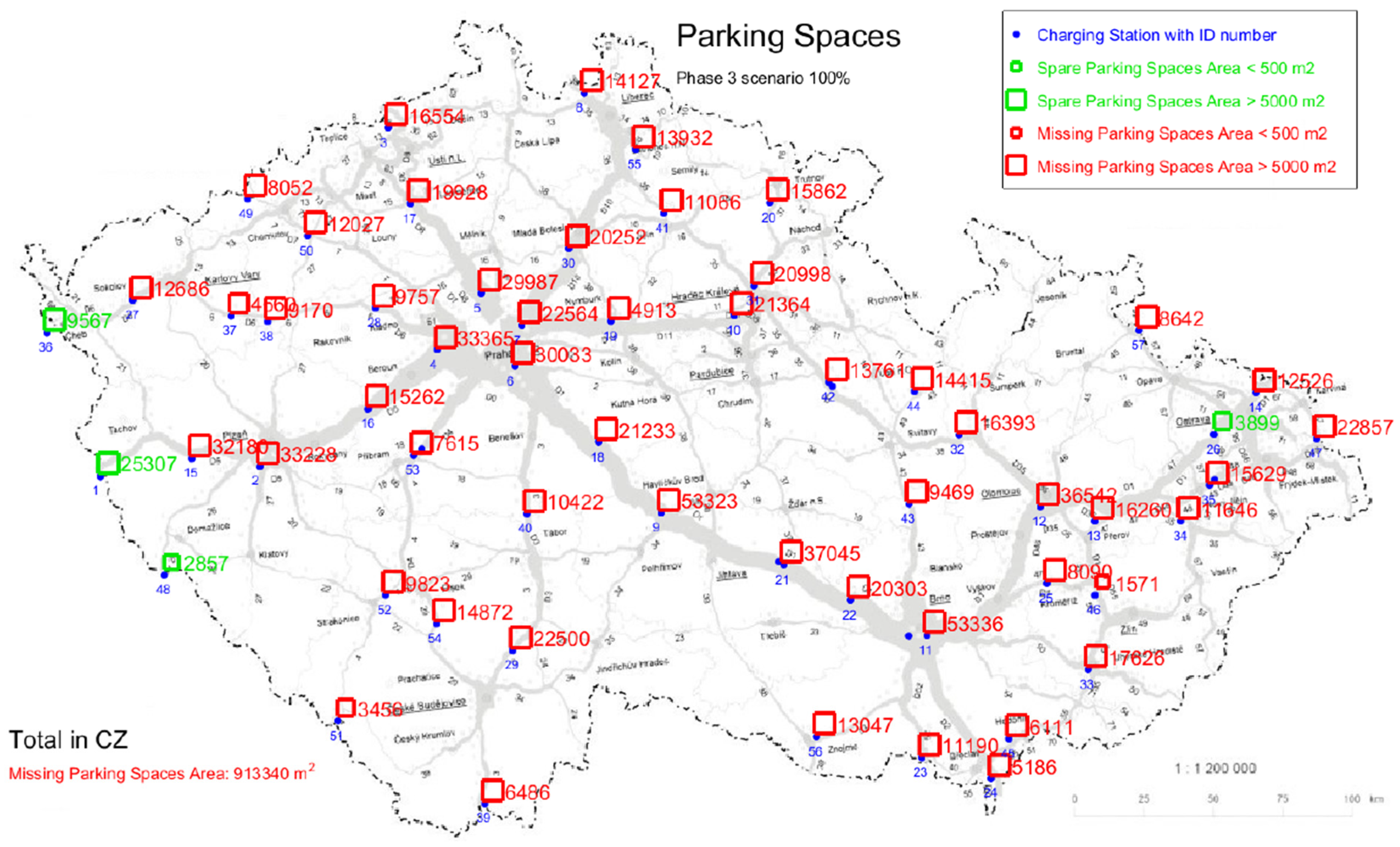
| Phase | Station ID | Type | Road Nr. | CHS Name | CHS Lon. (°N) | CHS Lat. (°E) | TR Lon. (°N) | TR Lat. (°E) | TR Name | TR Capac. (MVA) | Missing mv Line (km) | Parking Places (Pcs.) |
|---|---|---|---|---|---|---|---|---|---|---|---|---|
| Phase 1 | 1 | core | D5 | Rozvadov | 49.6490 | 12.5321 | 49.7920 | 12.6604 | Tachov | 5 | 0.6 | 218 |
| 2 | core | D5 | Šlovice | 49.6787 | 13.3289 | 49.6848 | 13.4239 | Černice | 24 | 0.6 | 64 | |
| 3 | core | D8 | Varvažov | 50.7118 | 13.9702 | 50.6866 | 14.0320 | Ustí Sever | 10 | 0.3 | 71 | |
| 4 | core | D5 | Rudná | 50.0336 | 14.2163 | 50.0543 | 14.2120 | Chýně | 15 | 0.4 | 50 | |
| 5 | core | D8 | Klíčany | 50.2072 | 14.4359 | 50.1340 | 14.4439 | Praha Bohnice | 5 | 0.2 | 28 | |
| 6 | core | D1 | Nupaky | 49.9841 | 14.6038 | 49.9952 | 14.6366 | Říčany | 1 | 0.3 | 120 | |
| 7 | core | D11 | Beranka | 50.1083 | 14.6389 | 50.0867 | 14.6145 | Běchovice | 39 | 0.2 | 49 | |
| 8 | comp | I/35 | Chrastava | 50.8175 | 14.9498 | 50.7895 | 15.0531 | Hrádek n.Nisou | 14 | 0.2 | 10 | |
| 9 | core | D1 | Humpolec | 49.5366 | 15.3324 | 49.5462 | 15.3376 | Humpolec | 17 | 0.2 | 28 | |
| 10 | core | D11 | Osice | 50.1371 | 15.6990 | 50.1841 | 15.8235 | Hradec Králové | 5 | 1.1 | 60 | |
| 11 | core | D1 | Brno | 49.1625 | 16.6615 | 49.1671 | 16.6313 | Komárov | 5 | 1 | 122 | |
| 12 | comp | D35 | Olomouc | 49.5538 | 17.2282 | 49.5633 | 17.2043 | Hněvotín | 10 | 1.6 | 18 | |
| 13 | core | D1 | Osek | 49.5105 | 17.5002 | 49.5030 | 17.4981 | Prosenice | 5 | 0.6 | 80 | |
| 14 | city | D1 | Antošovice | 49.9024 | 18.3069 | 49.8950 | 18.3367 | Bohumín | 10 | 1.1 | 53 | |
| Phase 2 | 15 | core | D5 | Kladruby | 49.7029 | 12.9876 | 49.7640 | 12.9980 | Stříbro | 18 | 0.2 | 30 |
| 16 | core | D5 | Záluží | 49.8548 | 13.8713 | 49.8309 | 13.8587 | Hořovice | 1 | 0 | 101 | |
| 17 | core | D8 | Siřejovice | 50.4808 | 14.0839 | 50.4159 | 14.0485 | Libochovice | 25 | 0.2 | 39 | |
| 18 | core | D1 | Střechov | 49.7520 | 15.0208 | 49.7017 | 14.9503 | Řimovice | 5 | 0.8 | 63 | |
| 19 | core | D11 | Vrbova Lhota | 50.1204 | 15.0829 | 50.0343 | 15.1724 | Kolín západ | 7 | 1.1 | 160 | |
| 20 | core | I/37 | Výšinka | 50.4829 | 15.8752 | 50.5766 | 15.9582 | Poříčí | 15 | 0 | 0 | |
| 21 | core | D1 | Kochánov | 49.3775 | 15.9464 | 49.3468 | 15.9977 | Velké Meziříčí | 11 | 2.9 | 42 | |
| 22 | core | D1 | Devět Křížů | 49.2698 | 16.2786 | 49.2774 | 16.2348 | Velká Bíteš | 20 | 1.1 | 53 | |
| 23 | core | D52 | Mikulov | 48.7895 | 16.6358 | 48.8151 | 16.6238 | Mikulov | 18 | 0.2 | 0 | |
| 24 | core | D2 | Lanžhot | 48.7267 | 16.9842 | 48.7812 | 16.9061 | Břeclav | 2 | 0.7 | 122 | |
| 25 | core | D1 | Křenovice | 49.3202 | 17.2610 | 49.3149 | 17.4494 | Kojetín | 1,5 | 2 | 48 | |
| 26 | core | D1 | Klimkovice | 49.7753 | 18.0976 | 49.8107 | 18.1519 | Ostrava Poruba | 20 | 1 | 166 | |
| 27 | comp | D6 | Staré Sedlo | 50.1847 | 12.6948 | 50.1607 | 12.6750 | Vítkov | 15 | 0.2 | 30 | |
| 28 | comp | D6 | Nové Strašecí | 50.1611 | 13.9052 | 50.1421 | 13.9751 | Tuchlovice | 18 | 0 | 5 | |
| 29 | comp | I/3 | Švamberk | 49.1171 | 14.5929 | 49.2097 | 14.7207 | Veselí n Lužnicí | 14 | 0.3 | 0 | |
| 30 | comp | D10 | Brodce | 50.3424 | 14.8735 | 50.3076 | 14.8482 | Dražice | 1 | 0.3 | 19 | |
| 31 | comp | I/35 | HradecKrálové | 50.2290 | 15.7972 | 50.2511 | 15.7674 | Všestary | 5 | 0 | 10 | |
| 32 | comp | I/35 | Mohelnice | 49.7737 | 16.8216 | 49.7496 | 16.6500 | Mor. Třebová | 10 | 0.9 | 10 | |
| 33 | comp | D55 | Uher. Hradiště | 49.0592 | 17.4665 | 49.0731 | 17.4627 | Uher.Hradiště | 2 | 0.3 | 25 | |
| 34 | comp | I/35 | Lešná | 49.5109 | 17.9307 | 49.4775 | 17.9580 | ValašskéMeziříčí | 5 | 0.3 | 15 | |
| 35 | comp | D48 | Libhošť | 49.6203 | 18.0737 | 49.6301 | 18.1422 | Příbor | 10 | 0.25 | 4 | |
| Phase 3 | 36 | comp | I/6 | Pomezí | 50.0869 | 12.2652 | 50.0969 | 12.3970 | Jindřichov | 4 | 0.4 | 97 |
| 37 | comp | I/6 | Verušičky | 50.1367 | 13.1848 | 50.0638 | 12.9972 | Toužim | 12 | 0.1 | 16 | |
| 38 | comp | I/6 | Lubenec Ležky | 50.1199 | 13.3670 | 50.2222 | 13.3924 | Podbořany | 20 | 0 | 5 | |
| 39 | comp | D3 | Dolní Dvořiště | 48.6492 | 14.4526 | 48.7323 | 14.5050 | Kaplice | 17 | 0.4 | 15 | |
| 40 | comp | D3 | Mitrovice | 49.5331 | 14.6632 | 49.4112 | 14.6898 | Tábor | 10 | 0.8 | 60 | |
| 41 | comp | I/35 | Jičín | 50.4503 | 15.3473 | 50.4081 | 15.3424 | Nová Paka | 20 | 0 | 20 | |
| 42 | comp | I/35 | Vysoké Mýto | 49.9346 | 16.1716 | 49.9848 | 16.1918 | Choceň | 10 | 1 | 75 | |
| 43 | comp | I/43 | Letovice | 49.5626 | 16.5727 | 49.4991 | 16.6405 | Boskovice | 3 | 0 | 0 | |
| 44 | comp | I/43 | Lanškroun | 49.9063 | 16.5994 | 49.8923 | 16.4506 | Česká Třebová | 15 | 0 | 2 | |
| 45 | comp | D55 | Lužice | 48.8473 | 17.0718 | 48.8781 | 17.1184 | Hodonín | 23 | 0.2 | 22 | |
| 46 | comp | D55 | Kurovice | 49.2847 | 17.5015 | 49.3151 | 17.4491 | Hulín | 1.5 | 1.5 | 80 | |
| 47 | comp | D48 | Chotěbuz | 49.7619 | 18.6091 | 49.7063 | 18.6198 | Ropice | 35 | 0.15 | 10 | |
| 48 | dopln | I/26 | Folmava | 49.3456 | 12.8499 | 49.4505 | 12.9491 | Domažlice | 1 | 0.5 | 60 | |
| 49 | dopln | I/7 | Hora sv. Šebes | 50.4955 | 13.2678 | 50.4500 | 13.4205 | Chomutov | 10 | 0.6 | 4 | |
| 50 | dopln | D7 | Velemyšleves | 50.3816 | 13.5659 | 50.3808 | 13.5748 | Triangle | 25 | 0.2 | 33 | |
| 51 | dopln | I/4 | Strážný | 48.9017 | 13.7194 | 49.0554 | 13.8056 | Vimperk | 14 | 0.5 | 9 | |
| 52 | dopln | I/4 | Rovná | 49.2848 | 13.9569 | 49.2966 | 14.1640 | Písek | 16 | 0.4 | 30 | |
| 53 | dopln | I/4 | Příbram | 49.7116 | 14.0968 | 49.7021 | 14.0156 | Příbram město | 6 | 0.3 | 20 | |
| 54 | dopln | I/20 | Protivín | 49.1983 | 14.2110 | 49.1877 | 14.3822 | Křtěnov | 30 | 0.7 | 7 | |
| 55 | dopln | I/10 | Malá Skála | 50.6458 | 15.2077 | 50.7069 | 15.0898 | Jeřmanice | 35 | 0.5 | 5 | |
| 56 | dopln | I/53 | Znojmo | 48.8537 | 16.1089 | 48.8382 | 16.1691 | Hodonice | 25 | 0 | 5 | |
| 57 | dopln | I/57 | Krnov | 50.0933 | 17.7219 | 50.0822 | 17.6813 | Krnov | 15 | 0 | 20 |
| Scenario | Vehicle Category According to [10] | Vehicle Class According to ECE | Year 2025 | Year 2030 | Year 2035 |
|---|---|---|---|---|---|
| Industry baseline | SN | N2 | 0.3 | 3.0 | 9.7 |
| SNP | N2 + O | 0.3 | 3.0 | 9.7 | |
| TN | N3 | 0.4 | 3.7 | 11.7 | |
| TNP | N3 + O | 0.7 | 6.2 | 19.9 | |
| NSN | N3 + O | 0.7 | 6.2 | 19.9 | |
| EV-Leaders | SN | N2 | 1.9 | 7.0 | 23.9 |
| SNP | N2 + O | 1.9 | 7.0 | 23.9 | |
| TN | N3 | 1.7 | 7.5 | 25.6 | |
| TNP | N3 + O | 1.0 | 9.5 | 32.5 | |
| NSN | N3 + O | 1.0 | 9.5 | 32.5 | |
| Road-2-Zero | SN | N2 | 3.9 | 10.5 | 32.4 |
| SNP | N2 + O | 3.9 | 10.5 | 32.4 | |
| TN | N3 | 3.5 | 11.0 | 33.9 | |
| TNP | N3 + O | 1.7 | 12.9 | 39.9 | |
| NSN | N3 + O | 1.7 | 12.9 | 39.9 |
| Result Set | Scenario | Traffic Feasibility | CHS Cap (MVA) | Energy (GWh/ann) | Techl. Area (m2) | Park. Area (m2) | MissPark (m2) | MissDistr (MVA) | Stat. Batt. (MWh) | ChPts 170 kW | ChPts 350 kW | ChPts 700 kW | ChPts Total |
|---|---|---|---|---|---|---|---|---|---|---|---|---|---|
| AFIR_EK | 2025 | 100.000 | 15.4 | 0.0 | 280 | 4315 | 0 | 0.0 | 3.4 | 77 | 11 | 0 | 88 |
| 2030 | 100.000 | 95.9 | 0.0 | 724 | 24,189 | 4865 | 5.0 | 20.2 | 468 | 57 | 0 | 525 | |
| 2035 | 100.000 | 119.0 | 0.0 | 745 | 29,743 | 10,832 | 7.5 | 29.5 | 578 | 68 | 0 | 646 | |
| AFIR_EP | 2025 | 100.000 | 22.0 | 0.0 | 287 | 3305 | 0 | 0.0 | 8.4 | 44 | 0 | 22 | 66 |
| 2027 | 100.000 | 68.0 | 0.0 | 720 | 9455 | 1928 | 0.0 | 25.3 | 136 | 0 | 68 | 204 | |
| 2030 | 100.000 | 137.0 | 0.0 | 800 | 21,068 | 3947 | 8.0 | 50.5 | 343 | 0 | 114 | 457 | |
| 2032 | 100.000 | 170.0 | 0.0 | 850 | 26,622 | 9088 | 12.0 | 67.3 | 442 | 0 | 136 | 578 | |
| Phase 1 | InB | 97.914 | 10.3 | 16.7 | 280 | 4641 | 0 | 0.0 | 0.0 | 22 | 34 | 0 | 56 |
| EVL | 97.477 | 15.6 | 32.1 | 280 | 7572 | 0 | 0.0 | 0.0 | 40 | 54 | 0 | 94 | |
| R2Z | 97.518 | 22.3 | 58.8 | 280 | 10,847 | 0 | 0.0 | 1.6 | 57 | 80 | 0 | 137 | |
| Phase 2 | InB | 99.683 | 54.8 | 152.8 | 700 | 28,148 | 4479 | 1.6 | 3.8 | 129 | 224 | 0 | 353 |
| EVL | 99.674 | 78.5 | 247.4 | 700 | 38,416 | 7849 | 4.8 | 4.1 | 179 | 305 | 0 | 484 | |
| R2Z | 99.672 | 101.5 | 341.7 | 733 | 49,716 | 11,232 | 8.2 | 17.5 | 236 | 393 | 0 | 629 | |
| Phase 3 | InB | 99.998 | 149.9 | 490.9 | 1168 | 73,062 | 18,004 | 15.3 | 11.8 | 327 | 596 | 0 | 923 |
| EVL | 99.997 | 240.3 | 844.9 | 1324 | 110,470 | 39,634 | 37.0 | 38.4 | 490 | 913 | 0 | 1403 | |
| R2Z | 99.997 | 294.8 | 1053.7 | 1501 | 132,620 | 56,929 | 52.1 | 76.2 | 579 | 1113 | 0 | 1692 | |
| Phase 3 | InB_700 kW | 99.997 | 159.5 | 490.9 | 1170 | 72,885 | 17,685 | 16.9 | 12.4 | 199 | 414 | 300 | 913 |
| EVL_700 kW | 99.997 | 251.7 | 845.0 | 1336 | 106,245 | 38,115 | 39.6 | 40.1 | 304 | 606 | 428 | 1338 | |
| R2Z_700 kW | 99.997 | 305.0 | 1053.7 | 1515 | 123,103 | 50,121 | 56.4 | 78.5 | 348 | 706 | 502 | 1556 | |
| Verif 100% | - | 99.998 | 1736.6 | 6445.7 | 6992 | 655,525 | 913,340 | 1185.9 | 440.3 | 3961 | 5257 | 0 | 9218 |
| 700 kW | 99.998 | 1758.8 | 6446.0 | 7073 | 549,733 | 710,376 | 1211.4 | 443.2 | 1730 | 3509 | 1967 | 7206 |
Disclaimer/Publisher’s Note: The statements, opinions and data contained in all publications are solely those of the individual author(s) and contributor(s) and not of MDPI and/or the editor(s). MDPI and/or the editor(s) disclaim responsibility for any injury to people or property resulting from any ideas, methods, instructions or products referred to in the content. |
© 2023 by the authors. Licensee MDPI, Basel, Switzerland. This article is an open access article distributed under the terms and conditions of the Creative Commons Attribution (CC BY) license (https://creativecommons.org/licenses/by/4.0/).
Share and Cite
Hospodka, J.; Sadil, J.; Bínová, H.; František, K.; Oldřich, H.; Magdalena, H.; Kristýna, N. Conceptual Design of Public Charging Stations for Freight Road Transport. Infrastructures 2024, 9, 7. https://doi.org/10.3390/infrastructures9010007
Hospodka J, Sadil J, Bínová H, František K, Oldřich H, Magdalena H, Kristýna N. Conceptual Design of Public Charging Stations for Freight Road Transport. Infrastructures. 2024; 9(1):7. https://doi.org/10.3390/infrastructures9010007
Chicago/Turabian StyleHospodka, Jakub, Jindřich Sadil, Helena Bínová, Kekula František, Hykš Oldřich, Hykšová Magdalena, and Neubergová Kristýna. 2024. "Conceptual Design of Public Charging Stations for Freight Road Transport" Infrastructures 9, no. 1: 7. https://doi.org/10.3390/infrastructures9010007
APA StyleHospodka, J., Sadil, J., Bínová, H., František, K., Oldřich, H., Magdalena, H., & Kristýna, N. (2024). Conceptual Design of Public Charging Stations for Freight Road Transport. Infrastructures, 9(1), 7. https://doi.org/10.3390/infrastructures9010007






